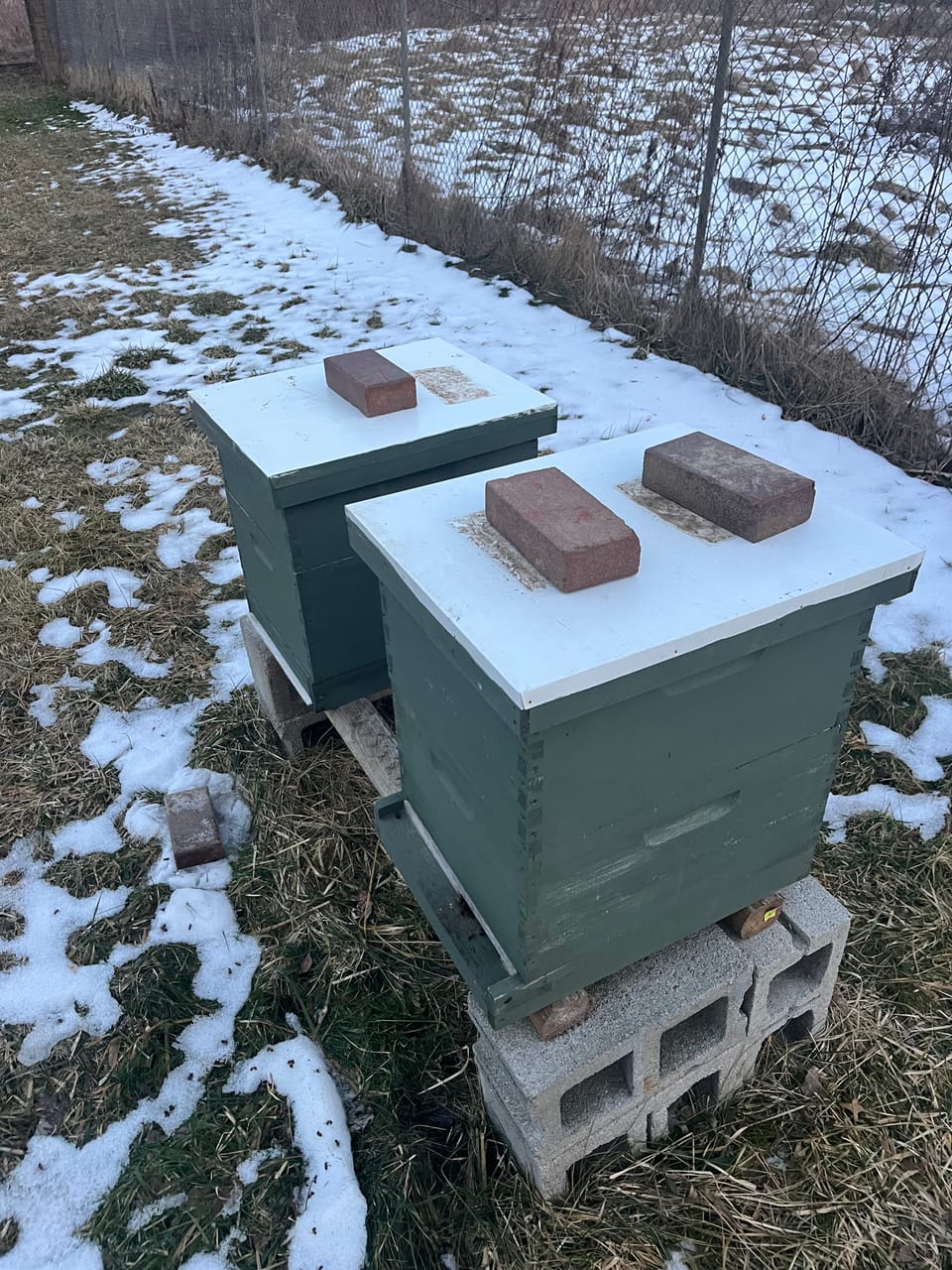Winter Beekeeping Update

For the first time since October 30th, I cracked open the telescopic lids on both hives to give the bees some sugar cakes. Today wasn’t the most ideal day for this task—the temperature only reached a high of 29°F, and a decent breeze was blowing from the northeast. However, with rain forecasted for tomorrow, today was the only window I had to get it done. I definitely didn’t want to risk opening the hives in the rain. I’m glad to report that I saw bees moving in both hives, which gives me confidence that, at least as of today, both colonies are still alive and holding on through the winter.
Hive #1 had a noticeable number of dead bees in front of the entrance. This hive was the stronger of the two going into the fall, so I expected to see more casualties due to the larger population. I started by taking my hive tool and cleaning out the entrance to clear the way for any bees that might venture out on warmer days. When I popped off the telescopic top, I noticed even more dead bees collected on top of the inner cover. Thankfully, I didn’t observe any moisture buildup inside the hive, which can be a significant issue in winter and lead to more bee deaths. Moisture combined with cold can spell disaster for a colony. While I didn’t clean out the dead bees from the top of the inner cover—I wanted to get the sugar cake in and close the lid quickly to minimize heat loss—I did see bees moving on top of the frames through the inner cover hole, which was reassuring.
Hive #2 presented a different scenario. There were only a few dead bees at the entrance, which made me worry that the hive might have been a dead-out—a term beekeepers use when an entire colony has died. With some apprehension, I cracked the lid open and, to my relief, didn’t find dead bees on the inner lid. Even better, I saw bees moving through the inner cover hole, which was a welcome sight. This hive seems to be doing better than I initially feared.
If you had spoken to me at the beginning of December, I would have confidently told you that my bees were set for the winter and that I wouldn’t be touching the hives until temperatures reached at least 65°F. Well, that policy has changed. Like many things in life, beekeeping is all about adapting to the circumstances, and this winter has certainly thrown some curveballs. Let’s dive into the reasons why I decided to give my bees some feed in the middle of winter.
First and foremost, we’ve experienced one of the coldest stretches here in Ohio in the last decade. January brought consistent temperatures in the teens, with a brutal four-day stretch where temperatures dipped as low as -10°F. This extreme cold had me questioning whether my bees had enough stored honey to survive such harsh conditions. Should I have fed them more in the fall? It’s a delicate balance. On one hand, I want to give my bees the best chance of making it through the winter. On the other hand, I don’t want to feed them unnecessarily. As a hobbyist beekeeper, I’m always learning, and one of my goals is to have self-sufficient hives that don’t require constant intervention.
Over the past few weeks, I’ve had time to research and listen to other beekeepers’ experiences and opinions. Hearing how mid-winter feeding has worked for others influenced my decision to intervene. One of my goals for 2025 is to expand my apiary to five hives. One strategy to achieve this is by making splits—dividing a strong hive into two separate colonies. To do that successfully, I need at least one of my current hives to come out of winter strong and healthy.
In addition to the sugar cakes, I’m planning to add a small pollen patty to each hive. This supplemental feeding can encourage early brood rearing, giving the colonies a head start in the spring. Early brood means a stronger workforce when nectar flows begin, which is essential for a productive season. However, adding pollen too early can also be risky if it triggers brood rearing before the bees can maintain the necessary temperatures, so I’ll be keeping a close eye on the weather and hive conditions.
Beekeeping, I’ve learned, is as much about observation and adaptation as it is about routine. Every hive is different, and every winter brings its own set of challenges. While I started this season with a hands-off approach, the extreme cold and my desire to ensure strong colonies for future growth have shifted my strategy.
I’m hopeful that these mid-winter interventions will make a positive difference. Seeing bees moving in both hives today was encouraging, and I’m optimistic that with a bit of support, both colonies will make it through to spring. Fingers crossed, I’ll have two solid hives come April, ready for splits and another season of growth. Beekeeping is a journey, and each season brings new lessons. Here’s to learning, adapting, and hopefully, thriving—both for me and my bees.
Member discussion